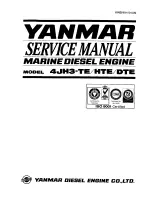
Operation Manual / 4 Product description / A100-M axial
6 Periodic maintenance / 6.5 Cleaning turbine and nozzle ring
© Copyright 2017 ABB. All rights reserved.
HZTL4033_DE
Revision B
December 2017
6.5.3
Cleaning method
Cleaning of the turbine and the nozzle ring during operation is carried out by the cleaning
method described in the following and is tested and approved by ABB Turbo Systems:
¡
Wet cleaning
Wet cleaning makes use of various effects. These effects are used with varying levels of in-
tensity, depending on the type of contamination:
¡
Erosion
The dirt is removed by the mechanical action of the impacting water droplets
¡
Solubility
Water solubility of the dirt deposits in water
¡
Thermal shock
Spalling of the dirt due to the temperature differential
CAUTION
Corrosion and deposits when cleaning
Salt water and cooling water treatment substances damage and adversely
affect turbocharger parts.
u
Never use salt water, but only pure water for cleaning.
The influence of the cleaning water on the peripheral units (such as the boiler) must be clari-
fied by the operator before commencing wet cleaning.
The turbine-end components are cleaned at reduced engine load. The exhaust gas temperat-
ure must not exceed the value specified in the cleaning instructions (see section Prerequis-
ites).
CAUTION
Reduced service life of the components
Failure to comply with the minimum stabilisation time before cleaning, the
prescribed turbine inlet temperatures and the drying time after cleaning sig-
nificantly reduces the expected service life of the components.
u
Comply with the cleaning parameters given in the tables
Cleaning parameters Wet cleaning of turbine and nozzle ring
.
V-engines
On V-engines with several turbochargers, we recommend the parallel cleaning of both tur-
bochargers for each engine. This cleaning process is faster and reduces the risk of surging
of the turbochargers.
Page
42
/
99
















































